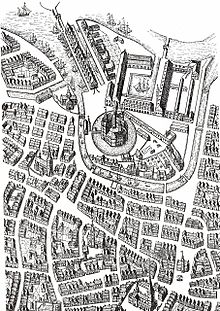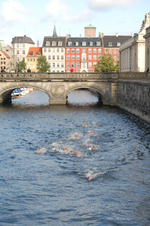Slotsholmen

Slotsholmen(English:The Castle Islet) is an island in the harbour ofCopenhagen,Denmark,and part of CopenhagenInner City.The name is taken from the successive castles and palaces located on the island sinceBishop Absalonconstructed the city's first castle on the island in 1167 at the site whereChristiansborg Palacelies today.
Recognised as the centre of theGovernment of Denmarksince theMiddle Ages,the island is sometimes referred to as 'the Island of Power' (Magtens Ø),[1]and is lined with central government institutions and ministries; the nameSlotsholmenis thus also frequently used as ametonymfor overall Danish governmental administration.
The island is dominated by the vastChristiansborg Palacewhich houses theDanish Parliament,theSupreme Court of Denmark,thePrime Minister's Officeand theState Roomsof theKing.Also located on the island are the most important ministries, theDanish National Archives,theRoyal Danish Library,several museums and the historic buildings of theChristian IV's Stock Exchange,theChancelleryandChristian IV's Brewhouse.[2]
History[edit]

The site used to consist of several small natural islands in the sound between the islands ofZealandandAmager.On the largest of these, Strandholmen (English: Beach Islet),Bishop Absalon of Roskildeconstructed a small castle in 1167. In 1250 the castle was extended with two side towers to get the appearance that is now depicted onCopenhagen's Coat of Arms.The castle was conquered by theHanseatic League1368 and pulled down the following year as part of peace terms. Shortly afterCopenhagen Castlewas built on the same site and it became the residence for the Danish king in 1443.[citation needed]
After the 1535-36 siege of Copenhagen during theCount's Feud,it became clear that the castle was outdated as a military installation, andKing Christian IIItransformed the castle from a military stronghold to a more liveable royal residence. However, the reconstruction took place in a rather haphazard way and continued during the reign of the following kings, resulting in a rather irregular appearance of the castle.[citation needed]
At the same time, it became clear that the castle was becoming too small to hold the functions necessary in order to function as a royal residence and seat of the administration so a series of smaller buildings began to be erected on Slotsholmen. Probably during the reign of Christian III a building was constructed on the quay of the canal in front of the castle to house the Chancellery. During the reign of Christian III andFrederick IIan arsenal was constructed by the beach south of the castle, and during the reign of Frederick II probably also a supply depot.[citation needed]

Under KingChristian IVSlotsholmen saw considerable development, especially in the southern part of the island. Here a new naval harbour was established, surrounded on one side by anArsenaland on the other side by aSupply Depot.Other new buildings constructed were theStock Exchangeand theBrewhouse.All four of these historic buildings are still there today.
By the time of the introduction of theabsolute monarchyin 1660, the role of Slotsholmen as the centre of administration was firmly established.[citation needed]
During the reign ofKing Frederick III,further lack of space in the castle led to the construction in 1665-1673 of an additional building between the Supply Depot and the Arsenal. This building, also still visible today, was to house theCabinet of curiositiesof the king, founded about 1650, and theRoyal Library,founded in 1648.[citation needed]

During the reign ofKing Frederick IV,a magnificent administration building was constructed in 1716-21 next to the palace adjacent to the Supply Depot. This new building was to house the chancelleries, thus replacing the previous chancellery building situated by the canal. The new chancellery building was connected to the castle by an arched passageway, thus allowing the king to stay in close contact with his government. The Chancellery Building (also known as theRed Buildingor theBuilding of Colleges) has functioned as the heart of the central administration for almost 300 years, and is today used by theMinistry of Finance.
In spite of many attempts and projects to replace the small and antiquated castle with a more up-to-date royal residence fit for an absolute king, the old castle continued to exist well into the 18th century. Several renovations were made, most notably by Frederick IV in 1721-29. This rebuilding thoroughly changed the irregular appearance of the castle to a more regular shape.[citation needed]

However, just two years after the rebuilding was completed, the Copenhagen Castle was demolished in 1731 to give room for three consecutiveChristiansborg Palaces,the two first of which were destroyed by fires (in 1794 and 1884). Parts of the first and second Christianborg Palace still remain and is integrated in the present palace. The ruins of Absalon's Castle and the Copenhagen Castle are excavated and at display today under the present Christiansborg.[citation needed]
Notable buildings[edit]
-
The entrance to Christian IV's Stock exchange on Slotsholmen
-
The Ministry of Education
-
Royal Danish Library,Old Building, seen from the Library Garden
-
The side façade of the Chancellery building
-
Black Diamondextension to theRoyal Danish Library
Bridges[edit]
Slotsholmen is surrounded partly by Copenhagen'sInner Harbour,partly by canals. Nine bridges connect Slotsholmen to the rest of Copenhagen, bothZealand-side andAmager-side.
Knippelsbro[edit]
Knippelsbrois abascule bridgeand one of several bridges over Copenhagen's Inner Harbour; others beingLangebro,Lille Langebro,Bryggebroenand Copenhagen'sInner Harbour Bridge.It connects Slotsholmen toChristianshavnby extending Børsgade to Torvegade.
Marmorbroen[edit]
Marmorbroen(English: The Marble Bridge) connects Christiansborg Riding Ground Complex to Ny Vestergade that continues to Dantes Plads with theNy Carlsberg Glyptotek.The bridge was constructed from 1739-45. It has asandstonecladding withmedallionornamentationon the sides while the top is covered with marble.
Stormbroen[edit]
Stormbroen(English: The Assault Bridge) is a small arch bridge in stone, connecting Stormgade (towardsThe City Hall Square) with Vindebrogade on Slotsholmen.
The bridge is named after theAssault on Copenhagenin 1659. It was at this very spot, where the city ramparts at that time was located, that theSwedishtroops made their principal attack. After a series of defeats, the Danish troops finally gained victory, the Swedish troops leaving 2,000 dead soldiers in front of the ramparts at Stormgade.
Various sources state that the bridge was erected in 1681 but on the side the inscription "erected in MDCLX is carved into its stone foundation. The bridge was renovated byMartin Nyropin 1918.
Højbro[edit]
Højbro(English: High Bridge) is an arch bridge inwrought iron,connecting Højbro Square with Slotsholmen. It is designed byVilhelm Dahlerupand was built in 1878. Holmens Bro and Børsbroen also used to be the work of Dahlerup but these have both been replaced.
The current bridge is not high at all. The name goes back to the wooden bascule bridge that was the first bridge to Slotsholmen.
Holmens Bro[edit]
Holmens Brois an arch bridge built in granite in 1954 to replace Dahlerup's design from 1878.
-
The Marble Bridge as seen from Frederiksholm Canal
-
Højbro connecting Højbro Square to Slotsholmen
-
Christian IV's Bro
-
Stormbroen
-
Holmens Bro
Round Christiansborg Open Water Swim[edit]

Since efforts to improve water quality in Copenhagen Harbour has made the water clean enough to allow swimming, an open-water swimming competition around Slotsholmen has been revitalized.[3]
With the course being 2,000 metres, the 10,000 metre race involves five loops. There is both a competition for amateurs who swim in the afternoon and aFINA 10 km (6 mi) Marathon Swimming World Cupevent with US$11,000 in prize money that takes place in the morning. The swim takes place in August and water temperatures are 18-22 °C.
The nature of the course makes it unusually good for spectators and that combined with the historical surroundings have gained it a reputation as one of the best open water swim competitions inEurope.[4]
See also[edit]
References[edit]
- ^Jytte Hilden:Slotsholmen, Magtens Ø.Copenhagen 2006. 202 p.
- ^Lars Bugge: Glemte broer i KøbenhavnArchived2012-02-22 at theWayback Machine
- ^"Open Water, Round Christiansborg".Wonderful Copenhagen.Retrieved2009-05-01.
- ^"Open Water Swimming: World's Top 100 Open Water Swims".Open Water Swimming.Retrieved2009-05-01.

















